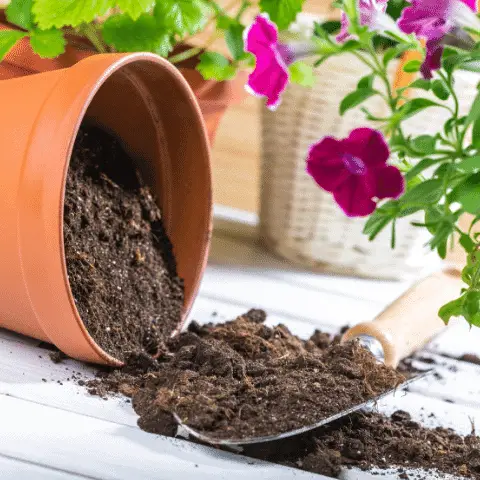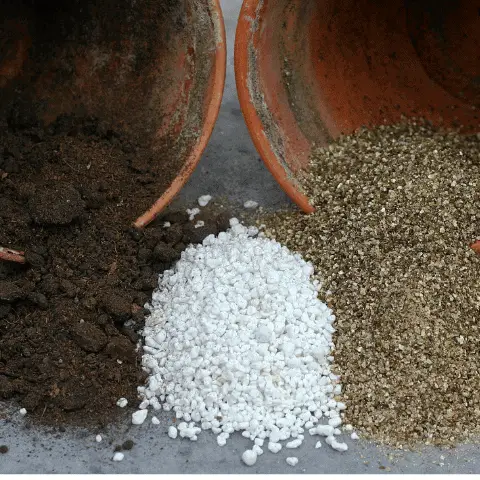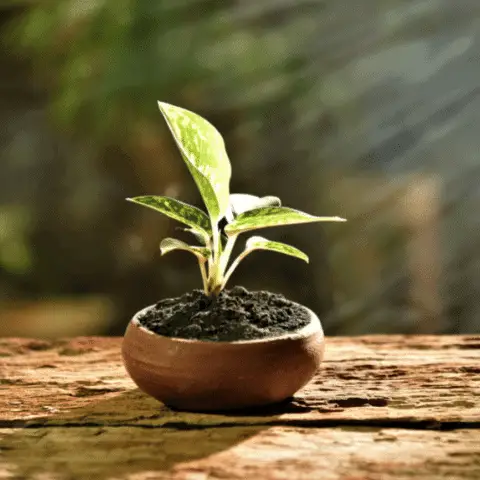You may have noticed that when you water your houseplant, its soil takes longer and longer to dry. This is a problem as most plants enjoy having their soil progressively dry out between each watering. If the soil does not do this, it could lead to severe problems for your plant that could cause it to die. So, what are the reasons your houseplants’ soil is not drying?
Here are the main five reasons your houseplants’ soil may not be drying correctly:
- Poor ventilation where the plant is kept
- You keep your plant in low light conditions
- Poorly draining soil
- You keep your plant in low temperatures
- Little or no drainage holes in the plant pot
How can you make your houseplants’ soil dry out faster to ensure the health of your plant? How long should it take for your houseplants’ soil to dry properly? Read the rest of the article to find out all this information and more!
Why Would Houseplant Soil Not Dry?
Worrying about your house plant’s soil not drying fast enough is a stressful situation as it could lead to some significant issues for your plant if it’s not fixed as soon as possible, such as mold and bug infestation (Pillbugs and Springtails, to name a few).
Unfortunately, there are several reasons why your houseplants’ soil is not drying properly.
All of these reasons relate to your plant’s soil not draining correctly, your plant decreasing its water usage, or problems with water evaporation and transpiration. Some of these issues can easily be fixed, while others may take time and work to correct. Let us see why your houseplants’ soil may not be drying.
1. Poor Ventilation Where The Plant Is Kept
Sometimes the location of your indoor plant can cause the soil to stay wet for too long. A significant cause of this issue is poor ventilation, which generally gets ignored when deciding where to put the plant in your home.
Placing your plant in a room with poor ventilation will decrease the rate of transpiration and evaporation of water from your plant’s soil. This can lead to your plant’s soil taking longer to dry out. This can then cause your plant’s soil to be waterlogged, leading to problems for your poor indoor plant.
2. Low Light Conditions
If you place your houseplant in a room that does not get very much light during the day, this can cause issues with your plant’s soil not drying quickly enough. Plants placed in low-light conditions will have trouble with wet soil, and their soil will stay damp longer after being watered.
This is because the plant will not be exposed to the hot sun, so it will not need a lot of water to stay hydrated. So, if you keep your plant in low-light conditions, then a large amount of the water that you give it will remain in the soil for a long time as the plant will not have much use for it.
3. Poorly Draining Soil
Soil that drains poorly can result in the soil of your houseplant being wet for too long and not drying out properly. If you water your plant and you notice that the water pools on the soil’s surface every time or that the water takes a long time to drain out of the plant pot’s drainage holes, then the soil itself is most likely the problem.
This means that the soil does not sufficiently drain the water for your indoor plant. Several ready-made houseplant soil mixes are good at retaining water, as some plants need this function, but these soil mixes tend to drain poorly, which can be a problem for other plants.
If you use these soil mixes for plants that do not need them, this can lead to issues for your plant and prevent the soil from drying the way it should.
4. Low Temperatures
Keeping your houseplant in low temperatures can cause reduced evaporation of water from your plant’s soil. This will slow down the rate your plant’s soil dries. Keeping your plants in low temperatures can cause more harm than causes the soil to dry slower.
Keeping your houseplants in low temperatures can also lead to your plant having reduced transpiration, and it can negatively affect the growth rate of your pant.
You need to monitor the temperature of the rooms that your houseplants are kept in and ensure they are not exposed to the temperature extremes on both ends of the scale. This will help you know the water requirements of your plant better and adjust your watering accordingly.
5. Little Or No Drainage Holes In Pot
If you are having an issue with your houseplants’ soil not drying fast enough, then you need to look at the plant pot you have put the plant in. if the plant pot does not have drainage holes, or the holes are small, then the water will stay in the soil and cause your soil to be waterlogged.
The drainage holes are there to drain the water out into a water tray to either be used by your plant later or to be evaporated as it is excess water and is not needed. Growing healthy plants in pots with no drainage holes is a highly challenging task and takes meticulous attention to detail, so if you cannot give this a lot of attention, use plant pots with drainage holes.
How To Make Houseplant Soil Dry Faster
Dealing with wet soil in your potted indoor plants can be a frustrating problem to go through. Now that we know the main causes that stop your indoor plant’s soil from drying, we can go over how to fix this problem.
It can be pretty challenging to get rid of excess water in your potted plant, and sometimes repotting your plant is not an option; for example, if you have a huge pot plant, then repotting it will be your exercise for the week. Let us look at some methods that you can use to help your plant’s soil dry faster.
Remove Stagnant Water From Around The Plant
If there has been no drainage due to little or no drainage holes in your plant pot, then you need to look for any excess water that can be poured out of the plant pot.

If there is a lot of water in the pot that the soil cannot absorb and it has no place to go, the water will build up and begin to smell. This water is now stagnant and can cause a lot of issues for your plant.
To check if your plant has any stagnant water in the pot, you need to carefully tilt the plant pot, move some of the soil away, and keep it there for a minute or two. If you start to see water beginning to pool in the area of the moved soil, then your plant pot has terrible drainage, leading to stagnant water build-up.
You need to try and remove as much of this water as possible without disturbing your plant too much. To do this, you can try to pour out the water carefully, or you can try to scoop it out with a small container or spoon.
Place The Plant In A Sunny Area
If you are having trouble with your plant’s soil not drying, then the easiest way to try and fix this issue is to move your plant into a sunnier location for a few hours. This will also help in the fight against any mold or pests living on the wet surface of the soil in the pot.
Some great ways of increasing the amount of sun the soil in the pot is getting when you place the plant in a sunny area include pruning any branches of the plant slightly to make sure nothing is in the way of the light reaching the soil.
You could also face your plant in a southern direction to help increase the amount of sun the plant and soil will receive. Do not leave your house plant in the sun for too long, especially if the plant likes shade. Instead, spread out the sunny time over a few days to help dry the soil.
Make Air Pockets Around The Plant
Plant roots do require some aeration in the soil to function and breathe properly. This is why it is essential to use suitable aerated soil for the type of plant you are planting. The wrong kind of soil can also contribute to stagnated water in your plant pot.
If you are unsure about the aeration of your plant’s soil, then it will not harm the plant if you try to increase the soil’s aeration slightly. You can easily do this by tilting the plant pot to one side, leaving it there for a minute, and then tilting it to the other side.
This movement of the soil will cause it to separate slightly from the surface of the plant pot. This will allow air to flow better around the plant’s roots and bring vital oxygen to the root system. This increased airflow in the soil will help dry out the soil faster too.
Increase Ventilation
Something that nature provides for plants that indoor plants do not usually get enough of is good ventilation or wind. This is often a part of gardening that is ignored but is it vital to the health of a plant.
Providing good air ventilation helps toughen the plant’s roots, increases pollination, and moves water vapor away from the soil that holds the plant. This, in turn, then helps the prevention of mold growth and stagnant water.
If you need to increase the ventilation for your house plant, you can place a small fan by the plant, at least three feet away and at a low speed. Watch your plant to ensure that it’s not getting too dry and that the wind is not pushing the plant over.
If you do not own a small fan for your plant, then you can try moving your plant near an open window or move your plant outside for an hour or two.
Change Out Your Potting Soil
If your indoor plant’s soil is not drying, then you may be using the wrong type of soil for your plant. For houseplants, you need to provide soil that has good drainage and that is loose and rich. If you use any other soil like clay soil, you will need to add some compost or sand to the clay soil to help break up the water-retaining clumps.
This is why using garden soil for potting your indoor plants is not a great idea, as most garden soils are clay-type soil and will need some adjustments to house a healthy indoor plant. You should also make sure that the soil you use is not too sandy as this can often drain too much and cause other issues for your plant.

If you are concerned about the soil your plant is currently in, you can repot your plant using a good quality organic potting soil that you can buy from any gardening store; remember not to pack it down as this will impede aeration of the soil.
How Long Should It Take Indoor Plant Soil To Dry
With indoor plants that have the right growing conditions and suitable soil, the soil should only take between 2-3 days to dry out nicely. But if you have waterlogged soil, you will need to treat this as this issue will not go away on its own.
The time it takes to fix this issue will depend on the method you use to help dry out your waterlogged soil. If appropriately treated, wet soil should only take about 2-3 days to dry out thoroughly. For example, if you are going to move your plant into a better ventilated or sunnier location, it may take three days for the soil to dry.
You need to remember that if the waterlogged soil has damaged your plant and it is dealing with a disease caused by the waterlogged soil, then the methods mentioned above may not be able to save your plant.
Conclusion
When your plant’s soil is not drying properly in the time that it is supposed to, this can cause you to worry as there are adverse effects of this that can harm your plant. These problems require a fast and effective fix to save your plant. Paying attention to your plant’s needs is an essential aspect of plant care, as sometimes their needs do change. Good luck with your drying your houseplants’ soil!
Some of the links above are affiliate links, meaning at no additional cost to you, I will earn a commission if you click through and make a purchase.
Articles you might be interested in:

